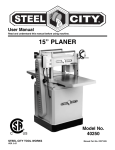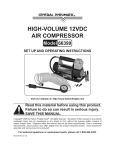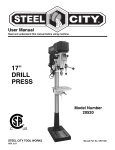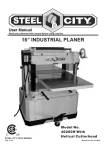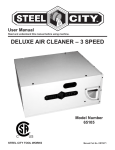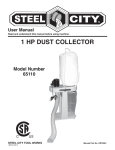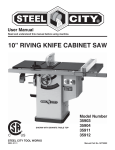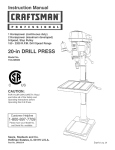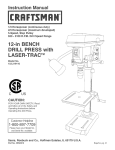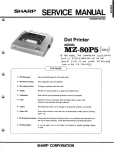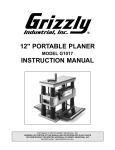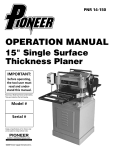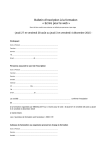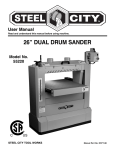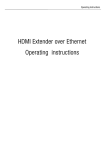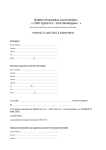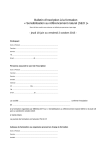Download 40270 - 20" Deluxe Planer w/ Parts Breakdown
Transcript
User Manual Read and understand this manual before using machine. 20” PLANER ® C US STEEL CITY TOOL WORKS Model No. 40270 Manual Part No. OR71873 eel City Planer. St w ne ur yo ng si ha rc pu THANK YOU for d inspected with an , ed st te , ed gn si de en This planer has be ed and mainus ly er op pr n he W d. in you, the customer, in m years of trouble free ith w u yo e id ov pr ill w tained, your planer by one of the longest ed ck ba is it hy w is ch service, whi the business. machinery warranties in oducts in the Steel pr y an m of e on st ju is This planer ry and is proof of ne hi ac m ng ki or dw oo w City’s family of satisfaction. er om st cu l ta to to t en our commitm cellence each and ex r fo ve ri st to ue in nt co At Steel City we customer. For r ou u, yo of n io in op e every day and value th Tool Works, please ity C l ee St or er an pl ur yo comments about tytoolworks.com . ci el te .s w w w at te si eb visit our w 2 TABLE OF CONTENTS INTRODUCTION SECTION 1 Warranty .................................................................................................................................................4 SECTION 2 Product Specifications ............................................................................................................................7 SECTION 3 Accessories and Attachments ................................................................................................................7 SECTION 4 Definition of Terms ..................................................................................................................................7 SECTION 5 Feature Identification ..............................................................................................................................8 SECTION 6 General Safety........................................................................................................................................9 SECTION 7 Product Safety ......................................................................................................................................11 SECTION 8 Electrical Requirements........................................................................................................................12 SECTION 9 Unpacking & Inventory..........................................................................................................................14 SECTION 10 Assembly ..............................................................................................................................................16 SECTION 11 Adjustments ..........................................................................................................................................18 SECTION 12 Operations ............................................................................................................................................27 SECTION 13 Maintenance .........................................................................................................................................29 SECTION 14 Troubleshooting ....................................................................................................................................30 SECTION 15 Parts List..........................................................................................................................................32-33 CHECK PAGE NUMBERS INTRODUCTION This user manual is intended for use by anyone working with this machine. It should be kept available for immediate reference so that all operations can be performed with maximum efficiency and safety. Do not attempt to perform maintenance or operate this machine until you have read and understand the information contained in this manual. This Planer is designed to process wood only. Any other use is forbidden. This machine is not to be modified for any reasons. The drawings, illustrations, photographs, and specifications in this user manual represent your machine at time of print. However, changes may be made to your machine or this manual at any time with no obligation to Steel City Tool Works. 3 WARRANTY STEEL CITY TOOL WORKS 5 YEAR LIMITED WARRANTY Steel City Tool Works, LLC (“SCTW”) warrants all “STEEL CITY TOOL WORKS” machinery to be free of defects in workmanship and materials for a period of 5 years from the date of the original retail purchase by the original owner. SCTW will repair or replace, at its expense and at its option, any SCTW machine, machine part, or machine accessory which in normal use has proven to be defective, provided that the customer returns the product, shipping prepaid, to an authorized service center with proof of purchase and provides SCTW with a reasonable opportunity to verify the alleged defect by inspection. This warranty does not apply to defects due directly or indirectly to misuse, abuse, negligence, accidents, or lack of maintenance, or to repairs or alterations made or specifically authorized by anyone other than SCTW. Normal wear components are also excluded under this coverage. Every effort has been made to ensure that all SCTW machinery meets the highest quality and durability standards. We reserve the right to change specifications at any time due to our commitment to continuous improvement of the quality of our products. EXCEPT AS SET FORTH ABOVE, SCTW MAKES NO EXPRESS OR IMPLIED REPRESENTATIONS OR WARRANTIES WITH RESPECT TO ITS MACHINERY, OR ITS CONDITION, MERCHANTABILITY, OR FITNESS FOR ANY PARTICULAR PURPOSE OR USE. SCTW FURNISHES THE ABOVE WARRANTIES IN LIEU OF ALL OTHER WARRANTIES, EXPRESS OR IMPLIED, INCLUDING THE WARRANTIES OF MERCHANTABILITY AND FITNESS FOR A PARTICULAR PURPOSE, WHICH ARE HEREBY SPECIFICALLY DISCLAIMED. SCTW SHALL NOT BE LIABLE FOR ANY (A) SPECIAL, INDIRECT, INCIDENTAL, PUNITIVE OR CONSEQUENTIAL DAMAGES, INCLUDING WITHOUT LIMITATION LOSS OF PROFITS, ARISING FROM OR RELATED TO THIS WARRANTY, THE BREACH OF ANY AGREEMENT OR WARRANTY, OR THE OPERATION OR USE OF ITS MACHINERY, INCLUDING WITHOUT LIMITATION DAMAGES ARISING FROM DAMAGE TO FIXTURES, TOOLS, EQUIPMENT, PARTS OR MATERIALS, DIRECT OR INDIRECT LOSS CAUSED BY ANY OTHER PARTY, LOSS OF REVENUE OR PROFITS, FINANCING OR INTEREST CHARGES, AND CLAIMS BY ANY THIRD PERSON, WHETHER OR NOT NOTICE OF SUCH POSSIBLE DAMAGES HAS BEEN GIVEN TO SCTW; (B) DAMAGES OF ANY KIND FOR ANY DELAY BY OR FAILURE OF SCTW TO PERFORM ITS OBLIGATIONS UNDER THIS AGREEMENT; OR (C) CLAIMS MADE A SUBJECT OF A LEGAL PROCEEDING AGAINST SCTW MORE THAN ONE (1) YEAR AFTER SUCH CAUSE OF ACTION FIRST AROSE. The validity, construction and performance of this Warranty and any sale of machinery by SCTW shall be governed by the laws of the Commonwealth of Pennsylvania, without regard to conflicts of laws provisions of any jurisdiction. Any action related in any way to any alleged or actual offer, acceptance or sale by SCTW, or any claim related to the performance of any agreement including without limitation this Warranty, shall take place in the federal or state courts in Allegheny County, Pennsylvania. STEEL CITY TOOL WORKS 4 WARRANTY CARD Name ________________________________________________ Street _______________________________________________ Apt. No. ______________________________________________ City _________________________ State ______ Zip __________ Phone Number_________________________________________ E-Mail ________________________________________________ The following information is given on a voluntary basis and is strictly confidential. Where did you purchase your STEEL CITY machine? Store: ____________________________________________ City:______________________________________________ 2. How did you first learn of Steel City Tool Works? ___ Advertisement ___ Mail Order Catalog ___ Web Site ___ Friend ___ Local Store Other_______________________ CUT HERE 3. 4. 5. 6. 7. Which of the following magazines ___ American Woodworker ––– Cabinetmaker ___ Fine Homebuilding ___ Journal of Light Construction ___ Popular Mechanics ___ Popular Woodworking ___ WOOD ___ WOODEN Boat ___ Woodsmith ___ Woodworker ___ Workbench What is your age group? ___ 20 to 29 years ___ 40 to 49 years ___ 60 to 69 years 9. How many Steel City machines do you own? _____________ 11. Which benchtop tools do you own? Check all that apply. ___ Belt Sander ___ Belt / Disc Sander ___ Drill Press ___ Band Saw ___ Grinder ___ Mini Jointer ___ Mini Lathe ___ Scroll Saw ___ Spindle / Belt Sander Other______________________ do you subscribe to? ___ American How-To ___ Family Handyman ___ Fine Woodworking ___ Old House Journal ___ Popular Science ___ Today’s Homeowner ___ Woodcraft ___ Woodshop News ___ Woodwork ___ Woodworker’s Journal Other_________________ 12. Which portable / hand held power tools do you own? Check all that apply. ___ Belt Sander ___ Biscuit Jointer ___ Dust Collector ___ Circular Saw ___ Detail Sander ___ Drill / Driver ___ Miter Saw ___ Orbital Sander ___ Palm Sander ___ Portable Thickness Planer ___ Saber Saw ___ Reciprocating Saw ___ Router Other_______________________ 13. What machines / accessories would you like to see added to the STEEL CITY line? ____________________________________________________ ____________________________________________________ Which of the following woodworking / remodeling shows do you watch? ___ Backyard America ___ The American Woodworker ___ Home Time ___ The New Yankee Workshop ___ This Old House ___ Woodwright’s Shop Other__________________________________________ What is your annual household ___ $20,000 to $29,999 ___ $40,000 to $49,999 ___ $60,000 to $69,999 ___ $80,000 to $89,999 How would you rank your woodworking skills? ___ Simple ___ Intermediate ___ Advance ___ Master Craftsman 10. What stationary woodworking tools do you own? Check all that apply. ___ Air Compressor ___ Band Saw ___ Drill Press ___ Drum Sander ___ Dust Collection ___ Horizontal Boring Machine ___ Jointer ___ Lathe ___ Mortiser ___ Panel Saw ___ Planer ___ Power Feeder ___ Radial Arm Saw ___ Shaper ___ Spindle Sander ___ Table Saw ___ Vacuum Veneer Press ___ Wide Belt Sander Other____________________________________________ Product Description:_____________________________________ Model No.: ___________________________________________ Serial No. _____________________________________________ 1. 8. 14. What new accessories would you like to see added? ____________________________________________________ ____________________________________________________ income? ___ $30,000 to $39,999 ___ $50,000 to $59,999 ___ 70,000 to $79,999 ___ $90,000 + 15. Do you think your purchase represents good value? ___Yes ___ No 16. Would you recommend STEEL CITY products to a friend? ___ Yes ___ No ___ 30 to 39 years ___ 50 to 59 years ___ 70 + years 17. Comments: ____________________________________________________ ____________________________________________________ ____________________________________________________ ____________________________________________________ ____________________________________________________ How long have you been a woodworker? ___ 0 to 2 years ___ 2 to 8 years ___ 8 to 20 years ___ over 20 years 5 FOLD ON DOTTED LINE PLACE STAMP HERE Steel City Tool Works P.O. Box 10529 Murfreesboro, TN 37129 FOLD ON DOTTED LINE 6 PRODUCT SPECIFICATIONS Capacities Product Dimensions Maximum stock width 20-in. Footprint 22-1/2 x 28-1/2” Maximum stock thickness 8-in. Length 55-1/2” Maximum depth-of-cut 1/8-in. Width 37” Minimum length of stock 7-in. Height 40-3/4” Feed Rate 16-20 FPM Weight 795 lbs. Cutterhead Shipping Dimensions Speed 5000 RPM Number of Knives 4 Diameter 3-3/16” Cuts Per Minute 20,000 Motor Specifications Type Induction Horsepower 5HP Amps 25 Voltage 230V Phase Single Hertz 60 RPM’s 3450 Carton Type Wooden Crate Length 29-1/2” Width 38-1/2” Height 48” Gross Weight 880 lbs. ACCESSORIES AND ATTACHMENTS There are a variety of accessories available for your Steel City Product. For more information on any accessories associated with this and other machines, please contact your nearest Steel City distributor, or visit our website at: www.steelcitytoolworks.com. DEFINITION OF TERMS Workpiece – The wood or lumber that you are working on. Chatter Marks – An uneven “washboard” type of cut caused by incorrect chipbreaker settings. Planing – Refers to the sizing of the lumber to a desired thickness, while creating a level surface. Chip Marks – Occurs when knives catch the chips and drag them across the lumber being planed, caused by exhaust blockage or improper chip deflector settings. Snipe – Gouging that occurs at the end of a board. Tear Out – Deep gouging caused by improper chipbreaker settings. 7 FEATURE IDENTIFICATION B C A D G E F A) Switch B) Return Rollers C) Table Raise/Lower Handwheel D) Bed Rollers E) Lifting Handles F) Access Panel G) Belt Guard 8 GENERAL SAFETY ! ! WARNING WARNING TO AVOID serious injury and damage to the machine, read and follow all Safety and Operating Instructions before assembling and operating this machine. This manual is not totally comprehensive. It does not and can not convey every possible safety and operational problem which may arise while using this machine. The manual will cover many of the basic and specific safety procedures needed in an industrial environment. Exposure to the dust created by power sanding, sawing, grinding, drilling and other construction activities may cause serious and permanent respiratory or other injury, including silicosis (a serious lung disease), cancer, and death. Avoid breathing the dust, and avoid prolonged contact with dust. The dust may contain chemicals known to the State of California to cause cancer, birth defects or other reproductive harm. All federal and state laws and any regulations having jurisdiction covering the safety requirements for use of this machine take precedence over the statements in this manual. Users of this machine must adhere to all such regulations. Some examples of these chemicals are: • Lead from lead-based paints. • Crystalline silica from bricks, cement and other masonry products. • Arsenic and chromium from chemically-treated lumber. Below is a list of symbols that are used to attract your attention to possible dangerous conditions. ! This is the safety alert symbol. It is used to alert you to potential personal injury hazards. Obey all safety messages that follow this symbol to avoid possible injury or death. ! Always operate tool in well ventilated area and provide for proper dust removal. Use a dust collection system along with an air filtration system whenever possible. Always use properly fitting NIOSH/OSHA approved respiratory protection appropriate for the dust exposure, and wash exposed areas with soap and water. DANGER Indicates an imminently hazardous situation which, if not avoided, WILL result in death or serious injury. ! 1. To avoid serious injury and damage to the machine, read the entire User Manual before assembly and operation of this machine. WARNING Indicates a potentially hazardous situation which, if not avoided, COULD result in death or serious injury. ! CAUTION ! WARNING Indicates a potentially hazardous situation, if not avoided, MAY result in minor or moderate injury. It may also be used to alert against unsafe practices. 2. ALWAYS wear eye protection. Any machine can throw debris into the eyes during operations, which could cause severe and permanent eye damage. Everyday eyeglasses are NOT safety glasses. ALWAYS wear Safety Goggles (that comply with ANSI standard Z87.1) when operating power tools. CAUTION CAUTION used without the safety alert symbol indicates a potentially hazardous situation which, if not avoided, may result in property damage. NOTICE This symbol is used to alert the user to useful information about proper operation of the machine. 9 ! 11. DO NOT FORCE the machine to perform an operation for which it was not designed. It will do a safer and higher quality job by only performing operations for which the machine was intended. WARNING 12. DO NOT stand on a machine. Serious injury could result if it tips over or you accidentally contact any moving part. 3. ALWAYS wear hearing protection. Plain cotton is not an acceptable protective device. Hearing equipment should comply with ANSI S3.19 Standards. ! 13. DO NOT store anything above or near the machine. 14. DO NOT operate any machine or tool if under the influence of drugs or alcohol. WARNING 15. EACH AND EVERY time, check for damaged parts prior to using any machine. Carefully check all guards to see that they operate properly, are not damaged, and perform their intended functions. Check for alignment, binding or breakage of all moving parts. Any guard or other part that is damaged should be immediately repaired or replaced. 4. ALWAYS wear a NIOSH/OSHA approved dust mask to prevent inhaling dangerous dust or airborne particles. 16. Ground all machines. If any machine is supplied with a 3-prong plug, it must be plugged into a 3contact electrical receptacle. The third prong is used to ground the tool and provide protection against accidental electric shock. DO NOT remove the third prong. 5. ALWAYS keep the work area clean, well lit, and organized. DO NOT work in an area that has slippery floor surfaces from debris, grease, and wax. 6. ALWAYS unplug the machine from the electrical receptacle when making adjustments, changing parts or performing any maintenance. 17. Keep visitors and children away from any machine. DO NOT permit people to be in the immediate work area, especially when the machine is operating. 7. AVOID ACCIDENTAL STARTING. Make sure that the power switch is in the “OFF” position before plugging in the power cord to the electrical receptacle. ! 18. KEEP protective guards in place and in working order. 19. MAINTAIN your balance. DO NOT extend yourself over the tool. Wear oil resistant rubber soled shoes. Keep floor clear of debris, grease, and wax. WARNING 20. MAINTAIN all machines with care. ALWAYS KEEP machine clean and in good working order. KEEP all blades and tool bits sharp. 8. AVOID a dangerous working environment. DO NOT use electrical tools in a damp environment or expose them to rain. ! 21. NEVER leave a machine running, unattended. Turn the power switch to the OFF position. DO NOT leave the machine until it has come to a complete stop. 22. REMOVE ALL MAINTENANCE TOOLS from the immediate area prior to turning the machine ON. WARNING 23. SECURE all work. When it is possible, use clamps or jigs to secure the workpiece. This is safer than attempting to hold the workpiece with your hands. 9. CHILDPROOF THE WORKSHOP AREA by removing switch keys, unplugging tools from the electrical receptacles, and using padlocks. 24. STAY ALERT, watch what you are doing, and use common sense when operating any machine. DO NOT operate any machine tool while tired or under the influence of drugs, alcohol, or medication. A moment of inattention while operating power tools may result in serious personal injury. 10. DO NOT use electrical tools in the presence of flammable liquids or gasses. 10 25. USE ONLY recommended accessories. Use of incorrect or improper accessories could cause serious injury to the operator and cause damage to the machine. If in doubt, DO NOT use it. 3. Prevent electrical shock. Follow all electrical and safety codes, including the National Electrical Code (NEC) and the Occupational Safety and Health Regulations (OSHA). All electrical connections and wiring should be made by qualified personnel only. 26. THE USE of extension cords is not recommended for 230V equipment. It is better to arrange the placement of your equipment and the installed wiring to eliminate the need for an extension cord. If an extension cord is necessary, refer to the chart in the GROUNDING INSTRUCTIONS section of this manual to determine the minimum gauge for the extension cord. The extension cord must also contain a ground wire and plug pin. ! WARNING 4. TO REDUCE the risk of electrical shock. DO NOT use this machine outdoors. DO NOT expose to rain. Store indoors in a dry area. 27. Wear proper clothing, DO NOT wear loose clothing, gloves, neckties, or jewelry. These items can get caught in the machine during operations and pull the operator into the moving parts. Users must wear a protective cover on their hair, if the hair is long, to prevent it from contacting any moving parts. 5. STOP using this machine, if at any time you experience difficulties in performing any operation. Contact your supervisor, instructor or machine service center immediately. 28. SAVE these instructions and refer to them frequently and use them to instruct other users. 6. Safety decals are on this machine to warn and direct you to how to protector yourself or visitors from personal injury. These decals MUST be maintained so that they are legible. REPLACE decals that are not legible. 29. Information regarding the safe and proper operation of this tool is also available from the following sources: Power Tool Institute 1300 Summer Avenue Cleveland, OH 44115-2851 www.powertoolinstitute.org 7. DO NOT leave the unit plugged into the electrical outlet. Unplug the unit from the outlet when not in use and before servicing, performing maintenance tasks, or cleaning. National Safety Council 1121 Spring Lake Drive Itasca, IL 60143-3201 8. ALWAYS turn the power switch “OFF” before unplugging the planer. American National Standards Institute 25 West 43rd Street, 4th floor New York, NY 10036 www.ansi.org ! ANSI 01.1 Safety Requirements for Woodworking Machines, and the U.S. Department of Labor regulations www.osha.gov WARNING 9. DO NOT handle the plug or planer with wet hands. 10. USE only accessories as described in this manual. USE accessories only recommended by Steel City. PRODUCT SAFETY 1. Serious personal injury may occur if normal safety precautions are overlooked or ignored. Accidents are frequently caused by lack of familiarity or failure to pay attention. Obtain advice from supervisor, instructor, or another qualified individual who is familiar with this machine and its operations. 11. DO NOT pull the planer by the power cord. NEVER allow the power cord to come in contact with sharp edges, hot surfaces, oil or grease. 2. Every work area is different. Always consider safety first, as it applies to your work area. Use this machine with respect and caution. Failure to do so could result in serious personal injury and damage to the machine. 13. REPLACE a damaged cord immediately. DO NOT use a damaged cord or plug. If the planer is not operating properly, or has been damaged, left outdoors or has been in contact with water. 12. DO NOT unplug the planer by pulling on the power cord. ALWAYS grasp the plug, not the cord. 14. DO NOT use the planer as a toy. DO NOT use near or around children. 11 15. ENSURE that the machine sits firmly on the floor before using. If the machine wobbles or is unstable, correct the problem by using shims or blocks prior to operation. 22. INSPECT all stock before planing, ensuring that there are no foreign objects embedded in the wood, loose knots, or knots that may become loose during operation. 16. This machine is designed to process WOOD ONLY. ! ! WARNING WARNING 23. DO NOT attempt to remove jams until power is disconnected and all moving parts have come to a complete stop. 17. NEVER position fingers or thumbs near the infeed roller. 24. MAKE SURE that there is adequate operating space on both the infeed and outfeed sides of the planer before operating. 18. Long pieces of stock should ALWAYS be supported with some type of fixture. 19. DO NOT operate planer with dull or damaged blades. 25. DO NOT attempt to plane wood that is less than 7” long or less than 1/8-inch thick. 20. MAKE CERTAIN that the planer is properly adjusted prior to use. 21. DO NOT try and remove excessive amounts of wood in one single pass. ELECTRICAL REQUIREMENTS ! WARNING DO NOT connect the machine to the power source before you have completed the set up process. DO NOT connect the machine to the power source until instructed to do so. TO PREVENT electrical shock, follow all electrical and safety codes, including the National Electrical Code (NEC) and the Occupational Safety and Health Regulations (OSHA). All electrical connections and wiring should be made by qualified personnel only. The switch provided with your planer is designed for 230V single phase use only. The switch has a power cord with no plug attached. There are many different configurations for 230 V outlets. A UL/CSA approved plug that matches the configuration of your 230V outlet must be installed before you can operate this tool. TO REDUCE the risk of electrical shock, DO NOT use machine outdoors. DO NOT expose to rain. Store indoors in a dry area. 12 GROUNDING INSTRUCTIONS ! A machine with a 230 volt plug should only be connected to an outlet having the same configuration as the plug. WARNING EXTENSION CORDS This machine MUST BE GROUNDED while in use to protect the operator from electric shock. ! In the event of a malfunction or breakdown, GROUNDING provides the path of least resistance for electric current and reduces the risk of electric shock. The plug MUST be plugged into a matching electrical receptacle that is properly installed and grounded in accordance with ALL local codes and ordinances. WARNING To reduce the risk of fire or electrical shock, use the proper gauge of extension cord. When using an extension cord, be sure to use one heavy enough to carry the current your machine will draw. If a plug is provided with your machine DO NOT modify the plug. If it will not fit your electrical receptacle, have a qualified electrician install the proper connections to meet all electrical codes local and state. All connections must also adhere to all of OSHA mandates. The smaller the gauge-number, the larger the diameter of the extension cord is. If in doubt of the proper size of an extension cord, use a shorter and thicker cord. An undersized cord will cause a drop in line voltage resulting in a loss of power and overheating. IMPROPER ELECTRICAL CONNECTION of the equipment-grounding conductor can result in risk of electric shock. The conductor with the green insulation (with or without yellow stripes) is the equipment-grounding conductor. DO NOT connect the equipment-grounding conductor to a live terminal if repair or replacement of the electric cord or plug is necessary. ! CAUTION USE ONLY a 3-wire extension cord that has a 3-prong grounding plug and a 3-pole receptacle that accepts the machine’s plug. Check with a qualified electrician or service personnel if you do not completely understand the grounding instructions, or if you are not sure the tool is properly grounded. If you are using an extension cord outdoors, be sure it is marked with the suffix “W-A” (“W” in Canada) to indicate that it is acceptable for outdoor use. PLUGS/RECEPTACLES Make certain the extension cord is properly sized, and in good electrical condition. Always replace a worn or damaged extension cord immediately or have it repaired by a qualified person before using it. ! WARNING Protect your extension cords from sharp objects, excessive heat, and damp or wet areas. MINIMUM RECOMMENDED GAUGE FOR EXTENSION CORDS (AWG) • Electrocution or fire could result if this machine is not grounded properly or if the electrical configuration does not comply with local and state electrical codes. 230 VOLT OPERATION ONLY • MAKE CERTAIN the machine is disconnected from power source before starting any electrical work. • MAKE SURE the circuit breaker does not exceed the rating of the plug and receptacle. The motor supplied with your machine is a 230 volt, 60 hertz, single phase motor. Never connect the green or ground wire to a live terminal 13 25’ LONG 50’ LONG 100’ LONG 0 to 6 Amps 16 AWG 16 AWG 14 AWG 6 to 8 Amps 16 AWG 16 AWG 12 AWG 8 to 12 Amps 14 AWG 14 AWG 10 AWG 12 to 15 Amps 12 AWG 12 AWG 10 AWG 15 to 20 Amps 10 AWG 10 AWG Not recommended UNPACKING & INVENTORY ! off with a soft cloth. This may need redone several times before all of the protective coatings are removed completely. WARNING • The machine is heavy; a forklift or overhead lift are required to lift the machine. After cleaning, apply a good quality paste wax to any unpainted surfaces. Make sure to buff out the wax before assembly. • Use a safety strap to avoid tip over when lifting machine. Compare the items to inventory figures; verify that all items are accounted for before discarding the shipping box. Check shipping carton and machine for damage before unpackaging. Carefully remove packaging materials, parts and machine from shipping carton. Always check for and remove protective shipping materials around motors and moving parts. Lay out all parts on a clean work surface. ! WARNING If any parts are missing, do not attempt to plug in the power cord and turn “ON” the machine. The machine should only be turned “ON” after all the parts have been obtained and installed correctly. For missing parts, contact Steel City at 1-877-SC4-TOOL. Remove any protective materials and coatings from all of the parts and the planer. The protective coatings can be removed by spraying WD-40 on them and wiping it A B A) Dust Port B) Extension Wings 14 C D E G H P I Q L J M K N O R S T (C) Handwheel (L) 6mm Allen Wrench (D) Handle (M) 5mm Allen Wrench (E) Lock Knobs (N) 4mm Allen Wrench (G) 10mm Hex Nut (O) 3mm Allen Wrench (H) 10mm Flat Washer (P) M8 x 25mm Hex Head Screws (I) (Q) M8 x 20mm Set Screws Key (J) 12-14mm Open End Wrench (R) M6 Round Head Screws (K) 8-10mm Open End Wrench (S) M6 Flat Washer (T) Knife Setting Jig 15 ASSEMBLY Before beginning assembly, take note of the following precautions and suggestions ! Fig. 1 CAUTION FLOOR This tool distributes a large amount of weight over a small area. Most commercial floors are appropriate for this unit, however, in residential use, flooring may need added reinforcement to accommodate the weight of the machine and operator. WORKING CLEARANCES Take into consideration the size of the material to be processed, space for auxiliary stands, work benches, etc. before setting up this machine. Make sure that you allow enough space for your machine to operate freely. A HANDWHEEL OUTLET PLACEMENT The purpose of the handwheel is for raising and lowering the planer table Outlets should be located close enough to the machine so that the power cord or extension cord is not in an area where it would cause a tripping hazard. Be sure to observe all electrical codes if installing new circuits and or outlets. ! 1. Locate the handwheel shaft at the front right corner of the planer. 2. Insert the key into the keyway on the handle shaft. 3. Line up the notch in the handwheel with the key and slide the handwheel onto the handle shaft. WARNING 4. Slide the direction scale over the shaft, making sure it rests against the center face of the handwheel. 1. DO NOT assemble the Planer until you are sure the tool is not plugged in. 5. Secure the handwheel using one 10mm hex nut and one 10mm flat washer provided. SEE FIG 2. 2. DO NOT assemble the Planer until you are sure the power switch is in the OFF position 6. Screw handle into the threaded hole on the handwheel. 3. For your own safety, DO NOT connect the machine to the power source until the machine is completely assembled and you read and understand the entire User Manual. ! Fig. 2 WARNING This planer is a very heavy piece of equipment. To assist with moving the unit, this Planer contains lifting handles (A) that slide out from the base of the planer head. SEE FIG 1. These handles can be used as lifting points using a forklift or overhead lift. Attempting to lift this unit without the proper equipment or adequate assistance could result in a serious injury. 16 EXTENSION TABLES DUST PORT The extension tables support the workpiece as it enters and exits the planer. This planer features a 5-in Dust Port for use with a dust collection system. If this planer is not to be hooked up to a dust collection system, DO NOT attach the dust port. 1. To mount the extension tables, thread three M8 x 20mm set screws into the bottom holes of the extension table. Only screw them in about 1/3 of the way for now. 1. Unbolt the upper cover from the planer to allow access to the screw holes. 2. Using three M8 x 25mm hex head mounting bolts, mount one extension table to the main table. SEE FIG 3. 2. To attach the dust port, mount the port under the upper cover on the planer. 3. Line up the 3 holes on the top of the dust chute with the 3 holes on the upper cover and fasten with three M6 round head screws, and three M6 flat washers. SEE FIG 5. Fig. 3 4. Use three M6 round head screws and three M6 flat washers and fasten the dust port to the body of the planer. 5. Rebolt the upper cover to the planer. Fig. 5 3. Place a straight edge on the main table so that it lies flat on the table and extends out over the extension table. SEE FIG 4. Fig. 4 4. Adjust the three set screws until edge of the extension table that is the furthest away from the main table is even with the straight edge. Please note that it may take several combinations of loosening and/or tightening the set screws and mounting bolts to get the extension table level with the main table. 5. Repeat steps 1-4 to attach the other extension table to the other side of the main table. 17 Fig. 6 KNIFE SETTING JIG The knife setting jig provides a convenient way to make setting the knives quick and simple. 1. To assemble the knife setting jig, snap one of the e clips (B) over the notch on one end of the knife setting rod (A). 2. Slide both of the knife setting jig brackets (C) onto the rod. 3. Snap on the other e clip to the opposite end of the rod. SEE FIG 6. ! CAUTION Planer knives are extremely sharp. Please use extra caution when your hands are near the blades. ADJUSTMENTS Some of the adjustments covered in this section have already been made at the factory. It is still a good idea to familiarize yourself with all of the following procedures so that you have a solid understanding of the planers operation. 2. Turn the handwheel clockwise to raise the table so that the block barely touches the left side of the body of the cutterhead. NOTE: Make sure that the block is actually touching the body of the cutterhead and not the knives. SEE FIG 7. TABLE PARALLELISM ADJUSTMENT 3. Slide the block to the right taking note of any gaps between the top of the block and the bottom of the cutterhead body. Measure any of these gaps with a feeler gauge. To make adjustments to the table, it is necessary to make a gauge block. When constructing this block, be sure to use a hardwood such as oak or maple. DO NOT use standard 2 x 4 material. A diagram for this block is located near the end of the manual. 4. When moving the block from left to right, if the block wedges tightly between the cutterhead and the table, repeat steps 2 and 3, but start from the right side of the cutterhead body and slide to the block to the left. NOTICE: A substitute for this gauge block would be to use a magnetic dial indicator. Anywhere it calls for use of the gauge block in this section, you may substitute with the dial indicator. ! Fig. 7 WARNING DO NOT make adjustments while the planer is running. Make certain that the switch is in the off position and that the machine is disconnected from the power source. ! CAUTION Planer knives are extremely sharp. Please use extra caution when your hands are near the blades. 1. Having the table parallel to the cutterhead is essential for planing stock perfectly square. Check this by placing the gauge block that you have constructed under the left end of the cutterhead. 18 5. Referring back to your measurements with the feeler gauge, if the gap difference from one side to the other is .004 or less, no adjustment will be necessary. CHAIN TENSION To adjust Chain Tension: 1. Remove the access panel (A) on the stand. SEE FIG 8A. If the gap is greater than .004, but less than .016, proceed to step 6. Fig. 8A If the gap is greater than .016, refer to the ADJUSTING CHAIN DRIVE section in the ADJUSTMENTS section of the manual. 6. For gap differences between .005 and .016, determine which side of the table needs to be raised to fix the gap. 7. Locate the two cap screws (A) in the table casting for each of the columns. SEE FIG 8. Fig. 8 A A 2. Loosen the two hex head bolts (B) that fasten the idler sprocket (C) to the base and move the idler sprocket until excess slack in the chain has been eliminated. SEE FIG 8B. 8. Loosen both sets of screws for each column on the side that needs adjusted. Fig. 8B 9. Pull up or push down on the table in the direction that it needs to move, hold in position and retighten the screws. 10. Repeat these steps until the variance is .004 or less. CHAIN ADJUSTMENTS The chain drive in your planer transfers movement from the hand wheel driven column to the three other support columns. The chain drive may require an adjustment to remove slack as the chain stretches over time, or as part of table leveling procedures. ! B WARNING 3. Retighten the two hex head bolts. MAKE CERTAIN THE MACHINE IS DISCONNECTED FROM THE POWER SOURCE. 4. Replace access panel. 19 C D ADJUSTING CHAIN DRIVE KNIFE INSPECTION Notice: The following steps should only be done AFTER you have gone through the TABLE PARALELLISM ADJUSTMENT section of this manual and the measurements you attained from that section are greater than .016 ! ! CAUTION Planer knives are extremely sharp. Please use extra caution when your hands are near the blades. The Planer knives are set at the factory using jack screws. Springs are also included with your planer which may be used instead of the jack screws, depending on your preference. These springs are installed beneath the knives. You can leave the springs in place as it will not affect the adjustments if they are not removed. If you prefer to use the spring adjustment method, you will need to remove each knife, remove the jack screws, leave the two springs under each knife and replace the knife. Follow the steps below if using the spring adjustment method. WARNING MAKE CERTAIN THE MACHINE IS DISCONNECTED FROM THE POWER SOURCE. 1. Remove the panel (A) to gain access to the chain drive assembly. SEE FIG 8A, page 19. 2. Loosen two hex head bolts (B) that fasten the idler sprocket (C) to the base until you can turn each corner sprocket (D) independently. One of the corner sprockets is shown in Fig 8B. SEE FIG 8B, page 19. ! WARNING MAKE CERTAIN THE MACHINE IS DISCONNECTED FROM THE POWER SOURCE. Notice: If the chain drive is loosened too much, it will fall off all of the sprockets. Replacing a chain that has come off the sprockets is a very tedious process. Make sure to loosen the idler pulley just enough to allow you to be able to turn the corner sprockets. 1. Remove the dust port and upper cover and cutterhead guard to expose the top of the cutterhead. SEE FIG 9. 3. Each tooth on a corner sprocket represents .016 of vertical movement as it turns. Fig. 9 4. Whichever end of the table is too high, turn the sprockets at that end of the table clockwise to lower the table. For example if the back end of the table is too high, the back two sprockets would need to be rotated clockwise to lower the back side of the table. If the right end of the table is too high, the right two sprockets would be rotated clockwise to lower the right side, etc. Notice: Make certain, as you turn the sprockets, to keep an accurate tooth count to ensure that the table is lowered equally on a specific side. 5. Recheck Table Parallelism using your gauge block. Once the tolerance is less than .016, replace access cover and refer back to the TABLE PARALELLISM ADJUSTMENT section in the ADJUSTMENT section of this manual. 2. Remove the belt guard. Turn the cutterhead (using the pulley) until the first knife is top dead center. 3. Using the knife setting gauge, check the knife height. The jig should set with both feet on the cutterhead. SEE FIG 10, page 21. If the knife is properly adjusted, the contact point at the center of the gauge should just touch the tip of the knife. If the knife does not make contact, or if the knife is high enough to cause the legs of the gauge not to set on the cutterhead, the knives will need adjusted. Be sure to inspect all 4 knives in the same manner. 20 Fig. 10 KNIFE ADJUSTMENT The knives are locked in the cutterhead with wedge type gibs and gib bolts. Springs located under the knives assist in setting the knife height. Jack screws under the knives allow fine tuning to help out in the setting process. 1. MAKE CERTAIN THE MACHINE IS DISCONNECTED FROM THE POWER SOURCE. 2. Remove the upper cover to expose the cutterhead. 3. Loosen the gib bolts until the knife is loose in the slot. The gib bolts turn clockwise to loosen and counterclockwise to tighten. SEE FIG 12. Fig. 12 The planer knives will need to be adjusted periodically and ultimately will need to be removed to be sharpened. Adjustments should be as precise as possible with tolerances within .002 -.003. This will help prolong the sharpness of the knife edges. Improperly adjusted knives can cause an imbalance condition in the cutterhead and shorten bearing life, as well as produce substandard results. Gib Bolt 4. Loosen the gib bolts by turning them clockwise until the knife is loose in the slot. Knife 5. Carefully remove the knife. 6. Unscrew the jack screws completely from the threaded hole and remove. Spring 7. Be sure that there is one spring in each of the two holes in the bottom of the knife slot. SEE FIG 11. NOTICE: The springs DO NOT go into the threaded hole where the jack screws were installed. 4. Place the knife setting jig over the knife on the cutterhead as shown in Fig. 13, page 22. The feet of the jig should be securely planted on the cutterhead, making sure the gauge rod remains parallel to the cutterhead. SEE FIG. 13 ON PAGE 22. Fig. 11 5. Lower the jack screws as low as possible. 6. Maintain a steady pressure on the knife setting jig while retightening the gib bolts. The springs in the cutterhead will push up on the knife allowing for proper alignment of the knives. 7. Once gib bolts are tightened, raise jack screws until they just touch the bottom of the knife. You should feel resistance when the jack screw touches the bottom of the knife. NOTICE: When making adjustments to the planer knives, all four knives must be adjusted the same. DO NOT adjust one knife without adjusting the others as this can result in knife damage, poor performance and possible injury to the operator. 21 5. Using a .040 feeler gauge between the gauge block and the cutterhead, raise the table until the knife just touches the feeler gauge. Fig. 13 6. Lock the table using the table lock knobs. 7. Remove your feeler gauge and slide the gauge block under one side of the chip breaker (D). The chip breaker should just touch the top of the gauge block. 8. Slide the gauge block to the opposite side of the chip breaker, checking it the same way. 9. If any adjustment is necessary, loosen the locknuts (E) and turn the setscrews (F). Stop turning when the chipbreaker just touches the top of the gauge block. SEE FIG 17. Fig. 17 CHIP BREAKER The chip breaker is located on the top side of the planer and it extends down around the front of the cutterhead. The purpose of the chip breaker is to prevent deep gouging, also known as tear-out, as the knives do their job. It works by breaking up the woodchips as they are being cut by the knives. The chip breaker also deflects and shoots out the woodchips away from the surface of the board and out the planer. ! H H G G E WARNING F DO NOT make adjustments while the planer is running. Make certain that the switch is in the off position and that the machine is disconnected from the power source. F 1. Remove the upper cover and dust port, and lower the table. 10. Retighten both locknuts and replace cover and dust hood. 2. Make sure that the knives are properly adjusted. PRESSURE BAR 3. Place the gauge block (A) on the table (B) directly under the cutterhead (C). SEE FIG 16. The pressure bar, like the chipbreaker, controls lumber as it passes under the cutterhead. The pressure bar helps to keep the lumber from lifting after it has been planed. Incorrect positioning of the pressure bar can result in a number of undesirable results such as snipe or chatter marks. Setting the pressure bar too low can also place excess load on the motor. To adjust the pressure bar: 4. Rotate the cutterhead until one of the knives are at its lowest point. Fig. 16 D C ! WARNING MAKE CERTAIN THE MACHINE IS DISCONNECTED FROM THE POWER SOURCE. 1. Remove top cover and dust port. 2. Loosen both locknuts (G). SEE FIG 17. A 3. Place Gauge block under the center of the pressure bar and adjust both of the setscrews (H) until the pressure bar just touches the tip of the block. 4. Once the bar is set, retighten both of the locknuts and replace top cover and dust port. B 22 Fig. 19 FEED ROLLER HEIGHT The infeed and outfeed rollers are responsible for moving the workpiece through the machine and pressing the workpiece flat against the main table. ! WARNING MAKE CERTAIN THE MACHINE IS DISCONNECTED FROM THE POWER SOURCE D 1. Lower the table so the gauge block (A) fits under one side of the infeed roller (B). E 2. Raise the table until the gauge block just barely touches one side of the infeed roller. SEE FIG 18. Fig. 18 C B 9. Loosen the roller adjustment check nuts (D) and turn the roller height set screws (E) to change the height of the roller. SEE FIG 19. 10. When the roller is set in the correct position, retighten the check nuts from step 9. 11. Recheck roller height and repeat steps 8-10 if necessary. FEED ROLLER PRESSURE Infeed and outfeed roller pressure is an important aspect of any planer. When the workpiece is fed through the planer, the correct amount of pressure will help ensure that the board does not slip (too little pressure) or does not jam (too much pressure). A 3. Push the gauge block through so that it is under the edge of one of the knives. NOTICE: Excessive pressure may damage workpiece It’s important to note that different lumber will require varying amounts of pressure, so you may have to experiment with different settings. While some rough cut lumber will go through the planer with little trouble at one pressure setting, other pieces may have some more difficulty. 4. Turn the cutterhead (C) by hand using the pulley until one of the knives are in its lowest position. 5. Using a feeler gauge, check the clearance between the top of the gauge block and the edge of the knife. Clearance should be .040. NOTICE: Adjusting the roller pressure does not affect height. 6. Repeat steps 1-5 for the opposite side of the roller. 7. Repeat this same process for the outfeed roller. If any adjustment is necessary continue on to step 8. ! 8. Remove the gear box cover to access the roller adjustments on the drive chain side on the planer. One socket head cap screw holds the drive chain cover in place. WARNING MAKE CERTAIN THE MACHINE IS DISCONNECTED FROM THE POWER SOURCE. 1. Before adjusting roller pressure, ensure that the knives and feed rollers are set correctly. NOTE: There are two metal guard plates bolted to the backside of the gear box cover. It may be necessary to remove one of these guards in order to remove the gear box cover. 2. Unscrew the four large pressure set screws (A and B) on the top of the planer body. SEE FIG 20. 23 5. Using a wrench, turn the eccentric shafts to adjust the roller height up or down as shown in FIG 21. Fig. 20 Fig. 21 B A 3. Remove the springs that are in the holes left by the set screws and check for any dirt or grit, cleaning off any dirt and replace springs. 4. Screw the three regular pressure set screws (A) back in until they are flush with the top of the head casting. 6. Repeat steps 1-5 until clearance is .002 to .005. 7. Retighten all set screws. 5. Screw in the light pressure set screw (B) until it is about 1/4” above the head casting. The reason this screw is not tightened as much as the other three is that the feed chain helps apply the needed tension to this side of the outfeed roller. 8. Spin rollers by hand to ensure that they move freely. 6. Tightening the set screws down further will INCREASE roller pressure, while backing them off will DECREASE roller pressure. CHIP DEFLECTOR The chip deflector (A) is the plastic plate under the top cover that keeps woodchips from falling onto the outfeed roller. SEE FIG. 22. BED ROLLERS ! The bed rollers aid the movement of the workpiece through the planer. The height of these rollers will vary depending on the types of wood. For rough stock, the rollers should be set slightly higher to keep the lumber from dragging along the bed. For smooth lumber, the rollers should be set just above the surface of the table. ! WARNING MAKE CERTAIN THE MACHINE IS DISCONNECTED FROM THE POWER SOURCE 1. The beveled edge of the deflector should be about 1/8”-1/4” from the knife edge. Check this by carefully rotating the cutterhead by hand to gauge the distance between the chip deflector and the knives. WARNING MAKE CERTAIN THE MACHINE IS DISCONNECTED FROM THE POWER SOURCE. ! CAUTION 1. Lay a straight edge across both of the table rollers. If the chip deflector is set too close to the knives, the rotating cutterhead may pull it in and destroy it. 2. Using a feeler gauge, measure the clearance between the bottom of the straight edge and the table. Make sure to measure in several places. 3. If measurement is between .002 and .005, the clearance is acceptable. If you do not have a measurement of .002 to .005 go to step 4. 2. If adjustment is necessary, loosen the three deflector mounting bolts. 4. Loosen the set screws located on both sides of each roller. 24 Fig. 22 ! WARNING DO NOT apply any oil or other lubricant to the antikickback fingers as this can attract dust and restrict the free movement of the fingers. This could result in damage to the planer, the workpiece, or even serious injury to the operator or others in the work area. DO NOT attempt to use the planer if the antikickback fingers are not functioning properly. A PULLEYS ! WARNING MAKE CERTAIN THE MACHINE IS DISCONNECTED FROM THE POWER SOURCE 3. Make sure the beveled edge of the deflector faces the cutterhead. 1. To inspect pulleys, place a steel ruler or other type of straight edge across the pulleys to check the alignment. If the ruler crosses them evenly, the pulleys are aligned correctly. SEE FIG 24. 4. Move the deflector until the edge is approximately 1/8” - 1/4” from the edge of the knives. 5. Push down on the deflector with a wooden stick and spin the cutterhead by hand to ensure that it does not contact the knives. ! Fig. 24 CAUTION Planer knives are extremely sharp. Please use extra caution when your hands are near the blades. 6. Retighten the chip deflector mounting bolts and remount the upper cover and dust port to the planer. ANTI- KICKBACK FINGERS Anti-kickback fingers (A) are an added safety feature on this planer. They are suspended from a rod that hangs across the front of the cutterhead casting. These fingers should be inspected regularly, ensuring that they swing freely and easily. SEE FIG 23. Fig. 23 2. If pulleys are out of alignment, loosen the bolts that hold the motor to the motor mount bracket. A 3. Adjust the motor position until the pulleys are aligned. 4. Retighten all bolts. 25 BELTS ! GEAR BOX The gearbox is located just behind the handwheel on the right side of the planer. The gearbox transfers power from the belt driven cutterhead to the power feed rollers. It has a two speed transmission that is controlled by a lever on the right side of the planer. When it is engaged, the power feed rollers will move the workpiece through the planer at either 16 ft/ min or 20 ft/min. The center position on the lever is neutral. WARNING MAKE CERTAIN THE MACHINE IS DISCONNECTED FROM THE POWER SOURCE 1. If the belt is too loose, remove the belt guard using the two threaded knobs. 2. To check belt tension, squeeze the Belts at their midpoint with moderate finger pressure. You should be able to deflect each belt no more than 3/4”. 1. To inspect gearbox, loosen the socket head cap screw on the gearbox cover. 3. Remove the panel at the back of the machine stand to access the motor assembly. 2. Pull the cover off the roll pins that hold it in place 4. The motor pivots on a platform suspended at one end by two threaded adjustment bolts. Adjust the locknuts (A) up or down the shafts until the desired belt deflection is achieved. SEE FIG 25. NOTE: There are two metal guard plates bolted to the backside of the gear box cover. It may be necessary to remove one of these guards in order to remove the gear box cover. Fig. 25 3. Inspect the bolts that hold the sprockets in place 4. Check the drive chains to make sure that the retaining clips are in place. SEE FIG 26. Fig. 26 A 26 OPERATIONS ! Fig. 27 WARNING This planer is a very powerful woodworking machine designed and built for professional use. Because of this, the machine should be operated with significant care and caution. Failure to do so could result in severe injury to the operator or others in the work area. Be sure to read this entire manual for all safety precautions before operating this machine. PLANER SUMMARY 1. Examine all lumber carefully for defects such as twisting, warping, knots, splits, crossgrain, and foreign objects such as nails, staples, etc before running it through the planer. If you are unsure about the quality of the wood, DO NOT USE IT!!! ! 2. Use the full width of the planer. Alternate between the left, right, and center when feeding lumber through the planer. Doing so will help extend the life of your blades. CAUTION The feed rate should be set ONLY while planer is running, and BEFORE the workpiece is inserted into the planer. DO NOT attempt to change speeds after the cutting operation has started. 3. Be sure to clean off all glue of joined boards before planing. 4. This planer is designed for natural wood only. DO NOT use any composites, laminates, particle board, plywood, or plastics in the planer. DEPTH LIMITER This planer is equipped with a depth limiter (A), located at the bottom of the cutterhead casting, which controls the maximum depth of cut to 1/8”. SEE FIG 28. With the limiter installed, you will not be able to cut more than 1/8” in a single pass. While it is possible to plane as much as 1/8” at a time, it is not recommended. Taking more shallow passes will improve the quality of your work as well as extend the life of your planer. 5. ALWAYS plane with the grain of the wood. NEVER feed end cut or end grained lumber through the planer. 6. When making multiple passes through the planer on long stock, use the stock return rollers located on top of the machine to move the workpiece over to the infeed side of the table. Fig. 28 7. Wood that has a high moisture content (greater than 20%) or wood exposed to rain or snow will plane poorly and cause excessive wear to the knives, and accelerate rust and corrosion. 8. This manual does not cover every aspect of planing wood. You should research alternative publications for more specific requirements. This type of follow up will help provide with a better understanding of the planing process as well as alert you to several precautions to take that may or may not be listed in this manual. A POWER FEED The power feed feature two different feed rates, 16 FPM (feet per minute) and 20 FPM. WHILE THE MACHINE IS RUNNING, moving the knob one direction produces the 16FPM setting while moving the other direction produces the 20FPM setting. There is also a central position for the knob, which is neutral. SEE FIG 27. NOTICE: To avoid mechanical damage to the planer, do not remove the depth limiter. 27 TABLE LOCKS TRIAL RUN Before attempting to adjust the table height, loosen the two black knobs (A) on the right side of the table. Once the table height is adjusted correctly, retighten the two knobs. SEE FIG 29. Once all the assembly is complete and the adjustments are complete, it’s time for a test run. Fig. 29 2. Press the start button. Keep your hand near the switch, ready to shut the machine down quickly in case anything does not sound right or if there appears to be a problem. 1. Turn on the power supply 3. The planer should run smoothly with little to no vibration or rubbing noises. If any strange noise is noticed, shut down machine and recheck all adjustments. ! WARNING Do not attempt to make adjustments while the machine is running. Make certain the machine is disconnected from the power source and the machine has come to a complete stop. ! WARNING A ALWAYS wear eye protection. Any machine can throw debris into the eyes during operations which could cause severe and permanent eye damage. Everyday eyeglasses are NOT safety glasses. ALWAYS wear Safety Goggles (that comply with ANSI standard Z87.1) when operating power tools. HANDWHEEL Turning the handwheel clockwise will raise the main table while turning it counterclockwise will lower the table. Crank the handwheel to raise or lower the table according to the desired workpiece thickness. Fig. 30 28 MAINTENANCE GENERAL GEAR BOX Make a habit of inspecting your planer each time you use it. Check the following conditions and repair or replace as necessary. 1. Worn Switch 2. Damaged cords and/or plugs 3. Damaged belts 4. Loose bolts 5. Any other condition that could hamper the safe operation of the machine Gear box oil should be drained after the first 20 hours of operation. Replace with 80W-90 gear oil for use in room temperature shops and 50W gear oil for unheated winter shops. Inspect levels periodically and change yearly for occasional use, more frequently with heavy use. To inspect oil level, 1. Using the short end of a hex wrench, dip the wrench inside the fill hole and rotate so the long end of the wrench is parallel to the table. 2. Remove the wrench. If the end of the hex wrench is coated with oil, then the gearbox level is okay. TABLE 3. If the end of the hex wrench is not coated with oil, then you need to add more oil. The table and other non-painted surfaces on the planer should be protected against rust. Be sure to wipe the table clean after every use. This will help prevent moisture from the wood condensing on the bare metal table. It is also a good idea to use a paste wax on the bare metal surfaces. This will help keep moisture from the table and hence help keep it from rusting. Over time, some rust may still develop on the table. To get rid of the rust, use some WD-40 and a fine steel wool. 4. Remove gear box cover. For information on removing gear box cover, refer to the gear box section in the ADJUSTMENTS section of this manual, page 26. 5. Replace fill plug when finished. DRIVE CHAIN The drive chain should be inspected and lubricated monthly using a general purpose grease. KNIVES FEED ROLLER Make sure that your knives are sharp and properly adjusted before each knives. The sharpness and proper setting of the knives is essential to good planing. Refer back to the section on knives in this manual for detailed instructions . The infeed / outfeed pressure setscrews double as the lubrication ports for the rollers. Add 1-2 drops of light machine oil to all ports before every use. Daily lubrication of feed rollers is CRUCIAL to the operation of the planer. Lubricate before start up. LUBRICATION LEAD SCREWS AND COLUMNS The four columns should be lubricated weekly with a light oil. The four lead screws (A) should be lubricated with general purpose grease once a month BEARINGS Your planer is equipped with factory sealed bearings requiring no lubrication during its lifetime. If the bearing should fail, the planer will produce a pronounced rumble that will get even louder under load. If it is allowed to get worse, overheating can occur and eventually the bearing can seize up, possibly causing damage to other parts of the machine. The lead screws and columns (B) should be wiped of any grease and dust build up at least once a week. They should be lubricated with light machine oil. SEE FIG 31. Fig. 31 WORM GEAR The worm gear should be inspected monthly and lubricated with a white lithium grease as needed. Remove the worm gear box to inspect. See parts diagram for location. A CHAIN The table height adjustment chain should be inspected regularly and lubricated as needed. Lubricate with a general purpose grease. B 29 TROUBLESHOOTING GUIDE This section covers the most common processing problems encountered in planing and what to do about them. Do not make any adjustments until planer is unplugged and moving parts have come to a complete stop. See the section on Wood Characteristics for additional troubleshooting information. PROBLEM LIKELY CAUSE(S) SOLUTION Motor will not start. 1. Low voltage. 1. Check power line for proper voltage. 2. Open circuit in motor or loose connections. 2. Inspect all lead connections on motor for loose or open connections. 1. Short circuit in line cord or plug. 1. Inspect cord or plug for damaged insulation and shorted wires. 2. Short circuit in motor or loose connections. 2. Inspect all connections on motor for loose or shorted terminals or worn insulation. 3. Incorrect fuses or circuit breakers in power line. 3. Install correct fuses or circuit breakers. 1. Motor overloaded. 1. Reduce load on motor. 2. Air circulation through the motor restricted. 2. Clean out motor to provide normal air circulation. 1. Short circuit in motor or loose connections. 1. Inspect connections on motor for loose or shorted terminals or worn insulation. 2. Low voltage. 2. Correct the low voltage conditions. 3. Incorrect fuses or circuit breakers in power line. 3. Install correct fuses or circuit breakers. 4. Motor overloaded. 4. Reduce load on motor. Machine slows when operating. 1. Feed rate too fast. 1. Change speed. 2. Depth of cut too great. 2. Reduce depth of cut. Loud, repetitious noise coming from machine. 1. Pulley setscrews or keys are missing or loose. 1. Inspect keys and setscrews. Replace or tighten if necessary. Motor will not start; fuses or circuit breakers blow. Motor overheats. Motor stalls (resulting in blown fuses or tripped circuit). Machine is loud when cutting. Overheats or bogs down in the cut. 2. Motor fan is hitting the cover. 2. Tighten fan or shim cover. 3. V-belt is defective. 3. Replace V-belt. 1. Excessive depth of cut. 1. Decrease depth of cut. 2. Knives are dull. 2. Sharpen knives. Infeed roller marks are left on the workpiece. Depth of cut too shallow. Increase depth of cut. Outfeed roller marks are left on right side of workpiece. Too much spring tension on feed roller. Refer to Feed Roller Pressure section for adjustment. Cannot control snipe. Long or heavy board sags as it enters and exits. Lift up on unsupported end of board as it enters and exits cutterhead. Machine howls on startup. Chip deflector too close to the cutterhead. Move chip deflector back 1/8” to 1/4” from the cutterhead. Table moves down while cutting. 1. Knives dull. 1. Replace knives. 2. Table locking knobs are loose. 2. Tighten table locking knobs. 30 31 N NOTES N 32 PARTS KEY NO. PART NO . DE S C R IP T IO N 1A O R 70406 MO T O R ( 5 H P, 2 2 0 -2 4 0 V, 1 P H ) 1B O R 70355 MO T O R S P E C P L AT E KEY NO . PART NO . 1 14 OR94007 1 15 O R 90280 Q T Y. DE S C R IP T IO N 13mm x 28mm x 3mm FLATWASHER M1 2 H E X N U T Q T Y. 4 4 1C O R 94269 C A P A C IT O R 1 16 O R 71814 MO T O R A D J U S T ME N T S H A F T A S S Y 2 2 OR94045 STRAIN RELIEF 1 17 OR71815 SUPPOR T SHAFT 2 3 O R 90219 5 mm x 5 mm x 3 0 mm K E Y 1 18 O R 70310 S P E C . P L AT E 1 4 O R 7 1 8 11 MO T O R P U L L E Y 1 19 O R 94271 HE X S C R E W 4 5 OR9031 1 M8 FLA T W A S H E R 1 20 OR94007 13mm x 28mm x 3mm FLAT WASHER 8 6 O R 93917 M8 x 2 0 mm H E X H E A D S C R E W 1 21 O R 90280 M1 2 H E X N U T 4 7 O R 71812 S PAC E R 1 22 O R 71816 MO T O R B A S E 1 8 OR94270 M8 x 12mm HEX SOC HD SET SCREW 3 23 O R 71817 C OVE R 2 9 O R 71813 MO T O R MO U N T IN G P L AT E 1 24 O R 90306 M6 x 2 0 mm P A N H E A D S C R E W 8 10 O R 91501 M8 H E X N U T 4 25 O R 94045 S T R A IN R E L IE F 1 11 OR9031 1 M8 FLA T W A S H E R 4 26 OR90308 M8 x 30mm HEX HEAD SCREW 2 12 O R 93891 M8 x 4 0 mm H E X H E A D S C R E W 4 27 * Start Capacitor 600MFD, 125 VAC 1 13 OR91499 M8 FLA T W A S H E R 4 33 34 KEY NO. PART NO. QTY. KEY NO. PART NO. 200 OR71818 201 OR91752 EXTENSION WING 2 233 OR94273 M5 x 10mm PAN HEAD SELF- TAPPING SCREW 32 M8 x 25mm HEX HEAD SCREW 6 234 OR71828 MOUNTING RING 16 202 OR91821 203 OR70949 M8 x 20mm SOC HD SET SCR 6 235 OR71829 MAIN COLUMN 1 COLUMN LOCK NUT 2 236 OR71830 COLUMN SHAFT 3 204 205 OR71819 COLUMN LOCK SHAFT 2 237 OR71831 COLUMN 3 OR94272 M8 x 16mm SOC HD CAP SCREW 8 238 OR71832 BASE 1 207 OR71820 BED CASTING 1 239 OR93524 M10 x 12mm SOC HD SET SCREW 8 208 OR70946 COLUMN LOCK BUSHING 2 240 OR94274 CHAIN 1 209 OR94015 KNOB 2 241 OR70958 CHAIN TENSIONER BRACKET 1 210 OR71821 BED ROLLER 2 242 OR70957 SPROCKET SHAFT 1 212 OR71822 ECCENTRIC SHAFT 4 243 OR71833 SPROCKET 1 213 OR94055 BALL BEARING (6201Z) 4 244 OR94024 RETAINING RING 1 214 OR90306 M6 x 12mm SOC HD SET SCREW 4 245 OR90311 M8 FLAT WASHER 2 225 OR94041 RETAINING RING 1 246 OR91752 M8 x 25mm HEX HEAD SCREW 2 226 OR71823 WORM 1 247 OR94021 BALL BEARING (6202ZZ) 4 227 OR94018 RETAINING RING 1 248 OR94022 RETAINING RING 4 DESCRIPTION DESCRIPTION QTY. 228 OR71824 BUSHING 1 249 OR71834 SPROCKET 4 229 OR71825 COLUMN LOCK NUT 4 250 OR90230 M10 FLAT WASHER 4 230 OR94019 4mm x 4mm x 10mm KEY 5 251 OR90228 M10 HEX NUT 4 231 OR71826 ELEVATING SCREW 1 252 OR94275 E - RING 4 232 OR71827 DUST SLEEVE 8 253 OR71835 SHAFT 4 35 36 KEY NO. PART NO. QTY. KEY NO. PART NO. 300 OR93899 M6 x 16mm SOC HEAD CAP SCREW 9 347 OR71844 CHIP GASKET 1 301 OR71836 302 OR71837 ROLLER BRACKET 3 348 OR71849 SPRING PLATE 1 ROLLER 2 349 OR71850 CUTTERHEAD CASTING 1 303 304 OR70965 HANDLE 1 350 OR93524 M10 x 12mm SOC HD SET SCREW 8 OR90280 M12 HEX NUT 1 351 OR91499 M8 FLAT WASHER 4 305 OR94007 13mm x 28mm x 3mm FLAT WASHER 1 352 OR90333 M6 x 12mm HEX HEAD SCREW 4 306 OR71838 HAND WHEEL 1 353 OR71851 SIDE COVER GUARD 1 307 OR71839 SPACER 1 356 OR94044 E-RING 2 308 OR94276 RETAINING RING 1 357 OR70955 SPACER 56 309 OR94055 BALL BEARING (6201Z) 1 358 OR70996 ANTI-KICK BACK FINGER 55 310 OR94019 4mm x 4mm x 10mm KEY 1 359 OR71852 ANTI-KICKBACK SHAFT 1 311 OR71840 ELEVATING WORM SHAFT 1 360 OR71853 KNIFE 4 312 OR94277 M6 x 50mm SOC HD CAP SCREW 3 361 OR71854 CUTTERHEAD 1 313 OR71841 ELEVATING SCREW GEARBOX 1 362 OR90863 M5 x 12mm PAN HEAD SCREW 8 314 OR71001 GEAR BOX OPERATION LABEL 1 363 OR94056 SPRING 8 315 OR92923 M8 x 40mm SOC HEAD CAP SCREW 1 364 OR94035 8mm x 8mm x 36mm KEY 1 316 OR71842 SIDE COVER 1 365 OR93522 BALL BEARING (6206-2NSE) 1 DESCRIPTION DESCRIPTION QTY. 317 OR94028 SPRING PIN 2 366 OR71855 KNIFE LOCKING BAR 318 OR71843 SIDE COVER GUARD 1 367 OR94033 HEX SCREW 4 319 OR94029 M6 x 12mm HEX HEAD SERRATED SCREW 4 368 OR94038 M6 x 16mm HEX HEAD SCREW 1 320 OR70974 CHAIN TENSIONER SHAFT 1 369 OR94052 6.2mm x 20mm x 3mm FLAT WASHER 1 321 OR70973 CHAIN TENSIONER 1 370 OR70985 OUTFEED ROLLER SPROCKET 1 322 OR70975 SHAFT 1 371 OR94037 5mm x 5mm x 22mm KEY 1 323 OR70976 BRACKET 1 372 OR71856 OUTFEED ROLLER 1 324 OR90311 M8 FLAT WASHER 1 373 OR94035 SPRING 4 20 325 OR94031 SPRING 1 374 OR70987 BUSHING 4 326 OR70978 SPRING HOOK PLATE 1 375 OR70988 RETAINER PLATE 4 327 OR94032 M6 x 10mm SOC HD CAP SCREW 2 376 OR93951 M6 x 16mm SOC HD SET SCREW 4 328 OR94278 M6 x 16mm HEX HEAD SERRATED SCREW 5 377 OR90235 M6 HEX NUT 4 329 OR71845 CHIP DEFLECTOR 1 378 OR94281 M8 x 18mm HEX HEAD SCREW 4 330 OR94030 SCREW 4 380 OR71857 SUPPORT SHAFT 1 331 OR90249 M8 x 50mm SOC HD CAP SCREW 4 381 OR90280 M12 HEX NUT 1 332 OR93951 M6 x 16mm SOC HD SET SCREW 2 382 OR71858 CHIP BREAKER SHAFT 1 333 OR71846 SCALE ASSY CONST. OF REF 334 TO 337 1 383 OR90306 M6 x 12mm SOC HD SET SCREW 2 334 OR71847 SCALE 1 384 OR90235 M6 HEX NUT 2 335 OR94279 M5 x 10mm SOC HD CAP SCREW 1 385 OR94041 RETAINING RING 1 336 OR71848 POINTER 1 386 OR71859 PRESSURE BAR MOUNT 2 337 OR90320 M6 x 12mm PAN HEAD SCREW 2 387 OR93917 M8 x 20mm HEX HEAD SCREW 2 338 OR94029 M6 x 12mm HEX HEAD SERRATED SCREW 6 388 OR91663 M8 LOCK WASHER 2 339 OR70982 SPRING PLATE 3 389 OR71860 PRESSURE BAR 1 340 OR93823 RIVET 4 390 OR94037 5mm x 5mm x 22mm KEY 1 341 OR70484 NAME PLATE 1 391 OR71861 CHIP BREAKER 1 342 OR90507 M5 x 8mm PAN HEAD SCREW 2 392 OR70992 INFEED ROLLER SPROCKET 1 343 OR70983 LIMIT PLATE 1 393 OR94052 6.2mm x 20mm x 3mm FLAT WASHER 1 344 OR94280 M6 x 20mm HEX SOC HD SET SCREW 2 394 OR94038 M6 x 16mm HEX HEAD SCREW 1 345 OR90235 M6 HEX NUT 2 395 OR94282 CHAIN 1 346 OR71848 ADJUSTING SHAFT 2 396 OR71862 INFEED ROLLER 1 37 38 KEY NO. PART NO. QTY. KEY NO. PART NO. 401 OR90290 402 OR90291 3MM WRENCH 1 425 OR90311 M8 FLAT WASHER 1 4MM WRENCH 1 426 OR91752 M8 x 25mm HEX HEAD SCREW 1 403 404 OR91728 5MM WRENCH 1 427 OR71010 BELT GUARD MOUNT 2 OR91729 6MM WRENCH 1 428 OR71011 BELT 3 405 OR90908 8MM / 10MM OPEN END WRENCH 1 429 OR71012 BELT GUARD FRONT 1 406 OR93975 12MM / 14MM OPEN END WRENCH 1 430 OR94050 KNOB 2 407 OR94283 OPEN END WRENCH 1 435 OR71866 POWER SWITCH 1 408 OR90333 M6 x 12mm HEX HEAD SCREW 6 436 OR94046 10 - 24 x 1 3/4 PAN HD SCREW 2 409 OR90059 M8 FLAT WASHER 6 437 OR71867 SWITCH MOUNT 1 410 OR71863 DUST CHUTE 1 438 OR90374 10 - 24 HEX NUT 2 411 OR71864 DUST HOOD 1 439 OR90053 #10 EXTERNAL TOOTH WASHER 2 412 OR93372 M6 x 12mm SOC HD CAP SCREW 6 440 OR93372 M6 x 12mm SOC HD CAP SCREW 2 413 OR90059 M8 FLAT WASHER 6 441 OR94045 STRAIN RELIEF 2 414 OR71865 CHIP GASKET 1 442 OR90304 M20 FLAT WASHER 4 DESCRIPTION DESCRIPTION QTY. 420 OR71008 CUTTERHEAD PULLEY 1 443 OR71000 MOTOR CORD 1 421 OR90616 5/16 - 18 HEX NUT 2 444 OR71868 POWER CORD 1 422 OR90311 M8 FLATWASHER 2 446 OR71006 KNIFE SETTING GAGE SHAFT 1 423 OR71009 BELT GUARD REAR 1 447 OR94049 E-RING 4 424 OR94029 M6 x 12mm HEX HEAD SERRATED SCREW 4 448 OR71869 KNIFE SETTING GUAGE 2 39 40 KEY NO. PART NO. 501 OR71870 GEAR BOX ASSY CONST. OF REF 502 TO 547 502 OR71871 CHAIN & TENSIONER ASSY CONST. OF REF 503 TO 511 1 DESCRIPTION QTY. KEY NO. PART NO. 1 524 OR92734 BALL BEARING (6201) 1 525 OR93936 M6 x 25mm SOC HD CAP SCREW 1 526 OR71019 GEAR 1 527 OR90366 BALL BEARING (6204ZZ) 1 528 OR93372 M6 x 12mm SOC HD CAP SCREW 1 529 OR94052 6.2mm x 20mm x 3mm FLAT WASHER 1 530 OR94053 OIL SEAL 1 531 OR94054 PLUG 1 532 OR71020 GEARBOX 1 533 OR94054 PLUG 1 534 OR71021 GEARBOX GASKET 1 535 OR94055 BALL BEARING (6201Z) 1 536 OR71022 GEAR ASSEMBLY 1 537 OR71023 SHAFT 1 503 OR70974 CHAIN TENSIONER SHAFT 1 504 OR70973 CHAIN TENSIONER 1 505 OR71872 TENSIONER BRACKET 1 506 OR94284 M6 x 35mm SOC HEAD CAP SCREW 1 507 OR90059 M6 FLAT WASHER 1 508 OR71026 SPROCKET 1 509 OR94285 CHAIN 1 510 OR94038 M6 x 16mm HEX HEAD SCREW 1 511 OR94052 6.2mm x 20mm x 3mm FLAT WASHER 1 512 OR94062 KNOB 1 513 OR94064 O-RING 1 514 OR71027 SHAFT 1 515 OR71028 SHIFTING CLAW 1 516 OR94029 M6 x 12mm HEX HEAD SERRATED SCREW 1 517 OR93936 M6 x 25mm SOC HD CAP SCREW 6 518 OR71015 PIN 2 519 OR71016 GEARBOX COVER 1 520 OR92734 BALL BEARING (6201) 1 521 OR94051 5mm x 5mm x 12mm KEY 1 522 OR71017 SHAFT 1 523 OR71018 GEAR 1 41 DESCRIPTION QTY. 538 OR94060 6mm x 6mm x 40mm KEY 1 539 OR94056 SPRING 1 540 OR94057 STEEL BALL 1 541 OR94058 OIL SEAL 1 542 OR94059 BALL BEARING (6204Z) 1 543 OR94055 BALL BEARING (6201Z) 1 544 OR71024 GEAR 1 545 OR94061 5mm x 5mm x 10mm KEY 1 546 OR71025 SHAFT 1 547 OR94055 BALL BEARING (6201Z) 1 OR71873 Manual (not shown) 1 OR71874 Manual French (not shown) 1 OR71875 Manual Spanish (not shown) 1 N NOTES N 42 STEEL CITY TOOL WORKS www.steelcitytoolworks.com 1-877-SC4-TOOL (1-877-724-8665) N 5 Year Warranty 43












































